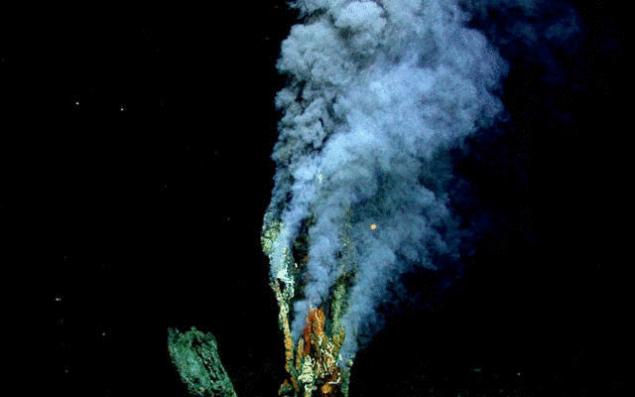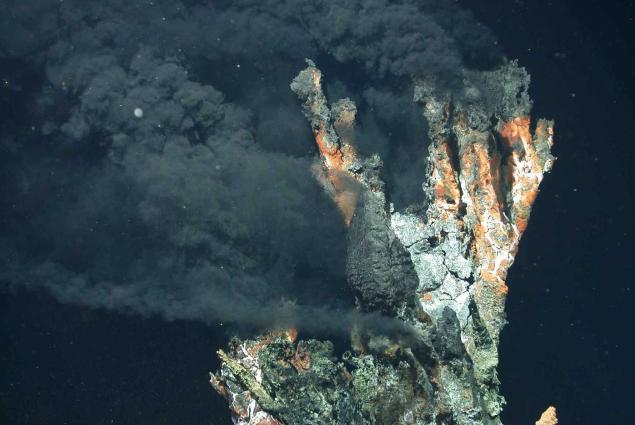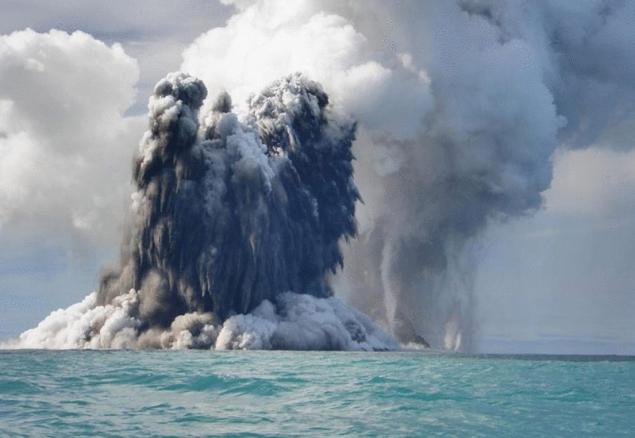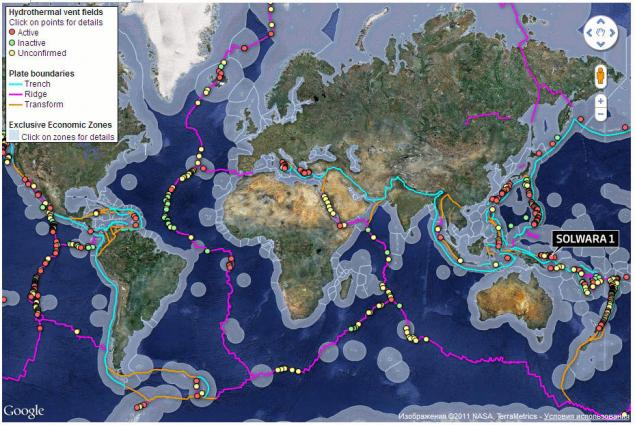Thermal energy on the ocean floor, hydrothermal vents
 Bashny.Net
Bashny.Net

Planet Earth is exempt from the primordial gas only after the juvenile magma of basaltic origin are poured out on its surface. Themselves of magma coming to the surface by oceanic ridges, which are located at mid-depth, and it is through their rift zone. Long known in these zones there are areas where there is water heating, and formed the so-called hydrothermal vents. The water is oceanic, i.e., zones are not formed by themselves. Thermal springs there are sources of thermal energy.
The end of the seventies of the last century was a breakthrough in science concerning the study of the oceans. On the ocean floor, scientists detected volcanic activity, and quite active. She, as it turned out, it is happening in rift zones. This discovery was a revolution in science. Many geologists and volcanologists had to re-examine the question of the origin of minerals, for example, sulfides, which were found in the areas of heating water and also some minerals. The researchers also found that the hydrothermal ore are formed without the involvement of exogenous substances. It was found that the sulfate sulfur has a special influence on the formation of sulfides. In addition, scientists have discovered the mechanism of methane of abiogenic origin, which appears in hydrothermal sources at the expense of thermal energy.

However, then, in the seventies the existence of sources of heated water in the ocean was only a suggestion. Not yet opened, these springs on the ocean floor. And power processes taking place in hot springs, was Terra incognito. How it was possible to calculate the theoretical availability of these processes? Scientists did some calculations and compared them with each other. First, they calculated the age dependence of the lithospheric plates and ocean heat loss of the same plates. Second, they calculated the empirical method and power level heat fluxes on the slopes of the ridges that were on the bottom of the ocean. Third, match all calculations. Scientists have established that empirical studies provide an opportunity to obtain information about the element conductive heat flow in rift zones. But theoretical calculations gave a full picture about the amount of thermal energy in these areas. The difference between the calculations — this was the amount of heat that produced water of the oceans. Moreover, these water existed, either in rift zones, or on slopes of the ridges on the bottom or in the cracks of the crust of the earth.
Presentaba energy, the amount of heat which is passed on the surface of the Earth, is huge. Thanks to these hydrothermal sites, the planet loses nearly a third of the energy of endogenous origin. And hot water take out energy at the level of 3.07*109 kW.
Ocean water heats up very much. So there are sources, which are called "black smokers". In them the water reaches the critical temperature of three hundred seventy-four degrees. Higher temperature can not be, otherwise the water will turn into gas. Due to the gas in these sources superheated water leaves the spinal oceanic cracks. Gas has low density and easily evaporates. In addition, if the temperature of ocean water exceeds three hundred and seventy-four degrees, it loses its so-called capillary properties, which are important in the impregnation of rocks. Therefore, the water does not reach those levels in waters where the temperature exceeds three hundred seventy-four degrees. That is why at the bottom of the "black smokers" there is no water, there are ocean rocks. Scientists call them Greenstone metamorphism.

Geologists conducted their study minerals on the ocean floor. The conclusions to which they came, have confirmed theoretical studies of the seventies. Here are some of the conclusions they did. There are so-called filetoview complexes. In their structure — dolerites, gabbros and basalts. At the bottom of the ocean, they change to the stage (facies), called metamorphism of green schists. The formation of this facies implies a temperature not higher than critical, i.e. approximately four hundred degrees Celsius. It turns out that the metamorphism is due to water existing in the water at a temperature close to critical (but not above it). Thus, according to the conclusions of geologists, a higher facies, for example, granulite, which occurs when supercritical temperatures occur only in those areas of the cortex that represent a closed system that does not allow dehydration. Typically, such systems arise in areas called subduction. According to geologists, there are exceptions to the rule. The highest stage of metamorphism occur at times and in rift zones, but under special conditions. For example, the ocean has been reset. Then formed the whole of the rift valley, which include methanoproline ranges and emit heat energy. Dike rocks, reached the stage salenational metamorphism, again descend into the rift, into the magma. In these rocks the water is interconnected, there will be their rebirth in the amphibolite facies. Geologists, however, believe that the rocks have reached that facies, play a minimal role in the formation and for the existence of oceanic crust of the day.
Oceanic crust absorbs less water. And for this there are a number of reasons. In cracks of bark fall pelagic sediments, there is their diagenesis. Crack tamponiruut. The water in the crust migrates and remains a chemogenic sediments. The latter are formed by processes in the hot springs. So scientists, when comparing empirical calculations of the amount of heat energy theoretical calculations have found that water stop flowing almost completely after a time of 50 Mu after the occurrence of the crust in the rift zone. Thus, it was proved that the thermal springs there usually exist where the age of the bottom is not more than 50 Mu. The average temperature in these areas does not exceed forty-two degrees Celsius. Recall that the "black smokers" much higher than three hundred seventy–four.

Normally, scientists expect water mass, which leads the washing of the crust of the ocean, with the balance of heat flows. They concluded that the amount of water that is filtered on the ridges and slopes — about 2300 cubic kilometers per year. It turns out that all ocean water is passed through hydrothermal vents at about six hundred thousand years. And in year for yourself rift zone are washed hot springs not so fast, at a speed of about twenty-two cubic kilometers per year. Then the whole ocean water is filtered through the so-called "black smokers" in around 60-70 Mu. If you consider that the ocean crust in rift zones occurs at low speed from about one gram to a kilogram per year. Therefore, water in the bark, located in hot springs, two times more than the breed. If this is not taken into account the water reacting with the rock. It is, however, to note that the bark and the species is formed not only in rift zones, but also outside their locations. So, if you add up the total speed of its formation, it will be slightly higher. Scientists usually speak about the speed, is equal to 4.7 – 1047 grams per year. It turns out that the ratio rock / water in the World's oceans, fifty-fifty. It turns out that the ocean crust and its constituent rocks have sufficient hydration.
What would it be? It turns out that the overall water exchange of the World ocean is much larger in scope than the degassing of water from the mantle. The first process is greater than the second, almost eight thousand five hundred times. The scientists also made a calculation of the rate of outgassing for four billion years, they took into account the entire hydrosphere mass and even the water in the earth's crust. It turned out that hydrothermal debit was higher than the amount of degassing of the hydrosphere nearly four thousand times. The conclusion is obvious: the ocean water in hot springs is doing much more for degassing and gives bolsheshapova energy than the entire hydrosphere.
When the crust of the ocean in a subduction zone is heated by friction of tectonic plates, it is dehydration. When this occurs the reaction of: a water and carbon dioxide trapped in the crust of the ocean waters. Formed olivine, diopside. This process is known as secondary degassing. On the secondary degassing and chemical during this process we will discuss in our second part of the article.
Source: zeleneet.com
Tags
See also
Artificial leaf could be the most effective source of renewable source of energy
10 unsolved mysteries of the Solar system
Why to reflect heat back into space
At the bottom of the ocean there are volcanoes
10 amazing galactic phenomena
10 unusual States of matter
The most unusual finds at the bottom of the ocean
New research gives hope of finding life on Enceladus
10 recent space discoveries no one can explain
The space race (32 photos)

















